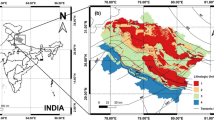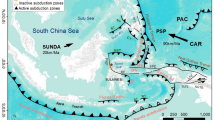Abstract
The probabilistic models achieved considerable attention in the field of seismology due to their dynamic properties. In this study, an attempt has been made to quantify the uncertainty observed in the earthquake data of the Hindu Kush region by using probabilistic models. The conditional probabilities of major earthquake (Mw ≥ 5.5) occurrence in the Hindu Kush region are estimated by using the Weibull, lognormal, gamma, and log-logistic probability distributions. The maximum likelihood estimation method has been used to estimate the model parameters. Results based on the three model selection criteria suggest that the Weibull and log-logistic distributions provide the most appropriate fit, while the lognormal and gamma distributions appeared as the second and third appropriate fitted distributions to the elapsed time data of the Hindu Kush region. Using the most appropriate fitted Weibull and log-logistic distributions, it has been observed that the estimated earthquake occurrence probability of magnitude 5.5 or greater in the Hindu Kush region reaches 0.94–0.99 within next 3 to 6 (2021–2024) years since the last event occurred in 2018 in the study region. The conditional probability values are continuously increasing with increasing time interval and it approximately reaches to one in next 6 to 12 (2024–2030) years without any elapsed time, i.e., (T = 0) years. The estimated earthquake conditional probability curves for different elapsed time and time interval values are also presented to understand the earthquake genesis in the study region. The earthquake mean recurrence interval is 0.68, 0.81, 0.68, and 1.11 years by using the Weibull, lognormal, gamma, and log-logistic models respectively. According to the obtained results, the earthquake of magnitude Mw ≥ 5.5 occurrence probability in the study region is significantly high. The obtained results provide important information’s regarding the underlying physical mechanism of earthquake generation process in the Hindu Kush region.



Similar content being viewed by others
References
Ambraseys N, Bilham R (2003) Earthquakes in afghanistan. Seismol Res Lett 74(2):107–123
Ambraseys N, Bommer J (1990) Uniform magnitude re-evaluation for the strong-motion database of Europe and adjacent regions. Eur Earthq Engrg 4(2):3–16
Anagnos T, Kiremidjian AS (1988) A review of earthquake occurrence models for seismic hazard analysis
Box-Steffensmeier JM, Jones BS (2004) Event history modeling: a guide for social scientists. Cambridge University Press, Cambridge
Chingtham P, Yadav R, Chopra S, Yadav AK, Gupta A, Roy P (2016) Time-dependent seismicity analysis in the Northwest Himalaya and its adjoining regions. Nat Hazards 80(3):1783–1800
Cluff LS, Patwardhan AS, Coppersmith KJ (1980) Estimating the probability of occurrences of surface faulting earthquakes on the Wasatch fault zone, Utah. Bull Seismol Soc Am 70(5):1463–1478
Cornell CA (1968) Engineering seismic risk analysis. Bulletin of the seismological society of America 58(5):1583–1606
D’Amico S (2012) Earthquake research and analysis: statistical studies, observations and planning. In-Tech, Croatia. https://books.google.com.pk/books?id=ZulxMwEACAAJ
Dong L, Zou W, Li X, Shu W, Wang Z (2019) Collaborative localization method using analytical and iterative solutions for microseismic/acoustic emission sources in the rockmass structure for underground mining. Engineering Fracture Mechanics 210:95–112
Gansser A (1980) The significance of the Himalayan suture zone. Tectonophysics 62(1-2):37–52
Gardner J, Knopoff L (1974) Is the sequence of earthquakes in Southern California, with aftershocks removed, Poissonian? Bull Seismol Soc Am 64(5):1363–1367
Hagiwara Y (1974) Probability of earthquake occurrence as obtained from a Weibull distribution analysis of crustal strain. Tectonophysics 23(3):313–318
Hashemi M, Alesheikh AA, Zolfaghari MR (2013) A spatio-temporal model for probabilistic seismic hazard zonation of Tehran. Computers & geosciences 58:8–18
Heyde C (1963) On a property of the lognormal distribution. J Roy Stat Soc Ser B Methodological 25(2):392–393
Idriss I (1985) Evaluating seismic risk in engineering practice: Proceedings of the eleventh international conference on soil mechanics and foundation engineering. Publication of Balkema (AA), San Francisco. 12-16 august 1985
Jordan TH (2006) Earthquake predictability, brick by brick. Seismol Res Lett 77(1):3–6
Khan MY, Mittnik S (2018) Nonlinear time series modeling and forecasting the seismic data of the Hindu Kush region. J Seismol 22(1):353–376
Knopoff L, Kagan Y (1977) Analysis of the theory of extremes as applied to earthquake problems. J Geophys Res 82(36):5647–5657
Lawson AC, Reid HF (1908) The California Earthquake of April 18, 1906: Report of the State Earthquake Investigation Commission. 87, Carnegie Institution of Washington
Ma J, Dong L, Zhao G, Li X (2019) Focal mechanism of mining-induced seismicity in fault zones: a case study of yongshaba mine in China. Rock Mech Rock Eng 52(9):3341–3352
McNally KC, Minster JB (1981) Nonuniform seismic slip rates along the Middle America Trench. Journal of Geophysical Research:, Solid Earth 86(B6):4949–4959
Mousavi M, Salehi M (2018) Temporal distribution of earthquakes using renewal process in the Dasht-e-Bayaz region. J Seismol 22(1):153–159
Nishenko SP, Buland R (1987) A generic recurrence interval distribution for earthquake forecasting. Bull Seismol Soc Am 77(4):1382–1399
Nowroozi AA (1971) Seismo-tectonics of the Persian plateau, eastern Turkey, Caucasus, and Hindu-Kush regions. Bull Seismol Soc Am 61(2):317–341
Parvez IA, Ram A (1997) Probabilistic assessment of earthquake hazards in the north-east Indian peninsula and Hindukush regions. Pure and Applied Geophysics 149(4):731–746
Parvez IA, Ram A (1999) Probabilistic assessment of earthquake hazards in the Indian subcontinent. Pure and Applied Geophysics 154(1):23–40
Pasari S (2015) Understanding Himalayan tectonics from geodetic and stochastic modeling. Unpublished PhD Thesis, Indian Institute of Technology Kanpur, p 376
Pasari S (2017) Stochastic modelling of earthquake interoccurrence times in Northwest Himalaya and adjoining regions. Proceedings of the 37th INCA International Congress
Pasari S (2018) Stochastic modelling of earthquake interoccurrence times in Northwest Himalaya and adjoining regions. Geomatics, Natural Hazards and Risk 9(1):568–588
Pasari S, Dikshit O (2015) Distribution of earthquake interevent times in northeast India and adjoining regions. Pure Appl Geophys 172(10):2533–2544
Rikitake T (1976) Recurrence of great earthquakes at subduction zones. Tectonophysics 35 (4):335–362
Ristau J (2009) Comparison of magnitude estimates for New Zealand earthquakes: moment magnitude, local magnitude, and teleseismic body-wave magnitude. Bull Seismol Soc Am 99(3):1841– 1852
Senior Seismic Hazard Analysis Committee (SSHAC) (1997) Recommendations for probabilistic seismic hazard analysis: guidance on uncertainty and use of experts. Tech. rep., Nuclear Regulatory Commission, Washington, DC (United States), CR-6372
Shanker D, Yadav R, Singh H (2007) On the seismic risk in the Hindukush-Pamir-Himalaya and their vicinity. Curr Sci 92(11):1625–1630. Retrieved January 27, 2021, from http://www.jstor.org/stable/24097729
Sil A, Sitharam T, Haider ST (2015) Probabilistic models for forecasting earthquakes in the northeast region of India. Bull Seismol Soc Am 105(6):2910–2927
Stacy EW (1962) A generalization of the gamma distribution. The Annals of mathematical statistics 33(3):1187–1192
Tapponnier P, Peltzer G, Armijo R (1986) On the mechanics of the collision between India and Asia. Geological Society, London, Special Publications 19(1):113–157
Uhrhammer R (1986) Characteristics of northern and central California seismicity. Earthquake Notes 57(1):21
Utsu T (1972) Aftershocks and earthquake statistics (3): analyses of the distribution of earthquakes in magnitude, time and space with special consideration to clustering characteristics of earthquake occurrence (1). Journal of the Faculty of Science, Hokkaido University Series 7, Geophysics 3(5):379–441
Utsu T (1984) Estimation of parameters for recurrence models of earthquakes. Bulletin of the Earthquake Research Institute University of Tokyo 59:53–66
Utsu T (2002) Statistical features of seismicity. Int Geophys Ser 81(A):719–732
Vere-Jones D (2006) The development of statistical seismology: a personal experience. Tectonophysics 413(1-2):5–12
Vere-Jones D (2010) How to educate yourself as a statistical seismologist. Community Online Resource for Statistical Seismicity Analysis 10
Weibull W, et al. (1951) A statistical distribution function of wide applicability. Journal of applied mechanics 18(3):293–297
Wells DL, Coppersmith KJ (1994) New empirical relationships among magnitude, rupture length, rupture width, rupture area, and surface displacement. Bulletin of the seismological Society of America 84 (4):974–1002
Yadav R (2009) Seismotectonic modeling of NW himalaya: a perspective on future seismic hazard. Unpublished Ph D Thesis Department of Earthquake Engineering IIT Roorkee India p 76
Yadav R, Bayrak Y, Tripathi J, Chopra S, Singh A, Bayrak E (2012) A probabilistic assessment of earthquake hazard parameters in NW Himalaya and the adjoining regions. Pure and applied geophysics 169(9):1619–1639
Yadav R, Tsapanos T, Bayrak Y, Koravos GC (2013) Probabilistic appraisal of earthquake hazard parameters deduced from a Bayesian approach in the northwest frontier of the Himalayas. Pure and Applied Geophysics 170(3):283–297
Yadav R, Tsapanos T, Koravos GC, Bayrak Y, Devlioti KD (2013) Spatial mapping of earthquake hazard parameters in the Hindukush–Pamir Himalaya and adjacent regions: Implication for future seismic hazard. Journal of Asian Earth Sciences 70:115–124
Yadav RBS, Tripathi JN, Rastogi BK, Chopra S (2008) Probabilistic assessment of earthquake hazard in Gujarat and adjoining region of India. Pure and applied geophysics 165(9-10):1813–1833
Yadav RBS, Tripathi JN, Rastogi BK, Das MC, Chopra S (2010) Probabilistic assessment of earthquake recurrence in northeast India and adjoining regions. Pure and applied geophysics 167(11):1331–1342
Yilmaz V, Celik H (2008) A statistical approach for estimating the probability of occurrence of earthquake on the northern Anatolian fault zone. IJNES 2(2):81–86
Yilmaz V, Erişoğlu M, Çelik H E (2011) Probabilistic prediction of the next earthquake in the NAFZ (North Anatolian Fault Zone), Turkey. Doğuş Üniversitesi Dergisi 5(2):243–250
Zeitler PK (1985) Cooling history of the NW Himalaya, Pakistan. Tectonics 4(1):127–151
Author information
Authors and Affiliations
Corresponding author
Additional information
Responsible Editor: Longjun Dong
Publisher’s Note
Springer Nature remains neutral with regard to jurisdictional claims in published maps and institutional affiliations.
Rights and permissions
About this article
Cite this article
Khan, M.Y., Shah, M.A. & Khanam, F. Earthquake stochastic modeling and estimating the probabilities of earthquake occurrences in Hindu Kush region. Arab J Geosci 14, 222 (2021). https://doi.org/10.1007/s12517-020-06412-5
Received:
Accepted:
Published:
DOI: https://doi.org/10.1007/s12517-020-06412-5




